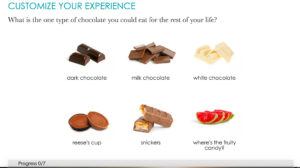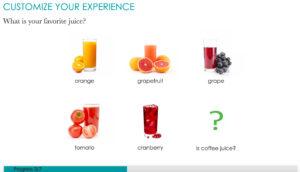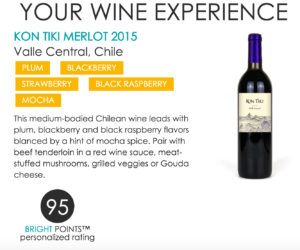Bright Cellars: The Pandora of Wine

Two MIT grads leverage big data to digitize wine selection and recommendation and democratize wine.
In 2014, Bright Cellars was the latest subscription box-based start-up to launch, taking the age-old idea of a wine club and giving it a high-tech touch.[1] Founded by two MIT grads, Joseph Larendi and Richard Yau, Bright Cellars’s tag line is “We want to help you discover wine!”[2][3] In August 2015, Bright Cellars closed a $1.8M seed round shortly after graduating from gener8tor, a start-up accelerator in Milwaukee, WI.[4]
Bright Cellars uses a propriety algorithm that matches you, the wine-drinker-to-be, with wine recommendations based off of a “taste palate quiz.”[5] Every month, they send out a new box of wine that their algorithm determines you’ll enjoy based off your quiz results…and the feedback you provide after your first box. Hence the Pandora bit.[6]
Their main goal is to move a novice wine drinker from mass-produced wines like Yellowtail or Barefoot to something more niche, like “hidden gems from small vineyards from all over the world, including Italy, Spain, Portugal, and South America.”[7] Bright Cellars is out to democratize wine and wine discovery, and is doing so leveraging big data and algorithms.
The taste palate quiz and how it works
Bright Cellars requires each customer to take its “taste palate quiz”, which compares 18 attributes to your preferences and leverages a proprietary algorithm to recommend wines.[8] The quiz has a variety of questions, including which type of chocolate you prefer, how you take your tea, and how adventurous you are with dining. After submitting, Bright Cellars displays a selection of wine recommendations, personalized for you, including Bright Points personalized rating. Preferences can be refined after consuming the wine—just as you’d give a thumbs up or down to a song in Pandora.[9] See Exhibits A and B for images of the taste palate quiz and the results.
Exhibit A Screenshots of the taste palate quiz: questions on chocolate and juice preference. Note the humor woven into the questions.
Exhibit B Screenshot of the results page of the quiz, post-algorithmic processing. Bright Cellars attributes a Bright Points personalized rating (its confidence, perhaps) for each of its recommendations. Have to say the results are pretty good; at least, it sounds like I’d like this wine.
The future
Bright Cellars hasn’t quite broken into the wine world yet. It’s moved into its tech start-up space just fine. But conquering the snobbish cloisters of wine geeks and snobs is a behemoth of a task that lies contrary to all thing tech start-up: wine drinking and knowledge are all about old world romance and history, the experience of discovery, not an automated spit-out of an algorithm, as Bright Cellars makes it out to be.[10] As one blogger wrote, it’s “a good place to start if you literally have no idea what you like and want to figure it out.”[11]
Algorithms are meant to replace the boring, tedious work and give us humans the space to be strategic and creative. So where can an algorithm that tries to automate wine selection fit in?[12]
The tasting notes of the wine world are infamous for their multitudinous nature, and for how ridiculous they sound. One glass of wine can be described as smelling like any or all of the following: raspberry, blackberry, boysenberry, cranberry, black cherry, briar…the list goes on. Raspberry can really mean fresh, dried, or even raspberry jam. Sometimes these adjective leave the conventional world of edible items: tar, wet cement, garden hose, petroleum.[13] So, the selection algorithm Bright Cellars uses has an incredibly rich selection of “data” points in this array of wine descriptors, which when a normal human has to think about can be quite overwhelming.
Even if Bright Cellars does not introduce amazing heralded wine and vintages to veteran wine connoisseurs, it does provide the simple value of directing a newbie to what he’ll like. Bright Cellars equips the novice drinker with the tools and descriptors necessary to take the leap to more niche wine. See Exhibit B: tasting notes most prevalent in that bottle are highlighted, giving the less informed consumer the necessary knowledge to speak about the wine. Bright Cellars, in digitizing wine taste, empowers its customers with the knowledge of what they like and enables them to make more confident wine choices.[14] As Bright Cellars continues to grow, the team should focus more and more on positioning themselves as a tool for those interested in wine who are unable to jump the hurdles to knowing more about wine and refining their discernment.
Whether an automated algorithm like Bright Cellars will ever be able to replace the function and mystique of a Master Sommelier is yet to be seen. And even if its functionally possible, does the customer who truly enjoys wine, including the excess of 300 words he can use to describe one single bottle, want to lose the chance to do so? Is there such a thing as over-digitizing wine and taste? Clearly there is a role for technology in wine tasting, but the balance between entry point facilitation via technology and deep enjoyment of aged wines has yet to be struck. (790 words)
[1] http://www.geekwire.com/2015/online-wine-club-uses-an-algorithm-to-find-you-the-perfect-wines/
[2] http://www.eater.com/drinks/2015/12/10/9881394/best-wine-club-delivery-online
[3] https://www.brightcellars.com/about-us/
[4] http://www.xconomy.com/wisconsin/2015/08/18/bright-cellars-snags-1-8m-to-expand-wine-delivery-service/#
[5] https://www.brightcellars.com/
[6] http://brandcheerleader.com/2014/05/28/bright-cellars/
[7] https://www.brightcellars.com/
[8] http://www.geekwire.com/2015/online-wine-club-uses-an-algorithm-to-find-you-the-perfect-wines/
[9] https://foodtechconnect.com/2015/09/30/food-tech-media-startup-funding-ma-and-partnerships-august-2015/
[10] http://www.forbes.com/sites/sap/2016/09/21/the-future-of-digitization-is-in-your-wine-glass/#21049edf6f01
[11] http://www.eater.com/drinks/2015/12/10/9881394/best-wine-club-delivery-online
[12] http://www.digitalistmag.com/future-of-work/2016/01/27/why-imperative-to-embrace-algorithms-in-future-03959869
[13] http://www.forbes.com/sites/sap/2016/09/21/the-future-of-digitization-is-in-your-wine-glass/#21049edf6f01
[14] http://www.forbes.com/sites/sap/2016/09/21/the-future-of-digitization-is-in-your-wine-glass/#21049edf6f01






It’s fascinating what Bright Cellars is trying to do but understandable that wine connoisseurs would frown upon such a technique to learn about other types of wine. This would likely have a negative knock-on impact on novice wine drinkers who see their more expert wine friends frown upon this technology.
Perhaps what Bright Cellar could do to get over the psychological hurdle of using big data in wine is to take a page out of Vivino’s book and combine their big data capabilities with Vivino’s wine scanning capabilities. Bright Cellars could have wine scanning capabilities to allow customers to not only store information on the exact label of wine they have tasted, but also – leveraging on Bright Cellars’ big data capabilities – find out what other wines are similar to the wine they tasted. They could also rate how much they liked the wine so that Bright Cellars’ algorithm will be able to understand what types of wines each customer would want vs. not want to be recommended. This might be a more “natural” and acceptable way for customers to discover the type of wine they like, instead of just taking a quiz.
I think it will be quite difficult to attract “novice” users to try out the app and I find it unclear how Bright Cellars will monetize their service. I think a good way for them to reach consumers is to partner with retailers. Put the app on tablets located in the wine section and recommend the wines available for consumers to pick up. I always struggle with the wine selection and pretty much what I do is go the a retailer and pick the wine type that I like at a sensible budget. I have to make the assumption that the more expensive the wine, the better it will taste, but that is certainly not always the case. Assuring buyers that a particular wine will fit well with their tastes will increase their confidence of picking up a more fancy wine, hence more profit to retailers.
I can see how Bright Cellars would create value for consumer who want to try new wines but aren’t sure where to start. If there isn’t a sales associate handy at the local wine shop, or the grocery store where you shop doesn’t employ wine experts, the stacks of wine can seem like a mystery. Whether or not the bottle label is well-designed doesn’t necessarily speak to the quality of its contents…
I think Bright Cellars’ biggest competitors are the local wine shops with in house experts. As for mass-market retailers like grocery chains, I wonder if they’ll eventually take cues from companies like Bright Cellars and develop their own platforms to pair consumers with in-stock wines within a consumer-determined price range. Regardless, it seems like a great time to be a wine drinker who wants to discover new products.
This is a noble effort by Bright Cellars and certainly an interesting one. My question is – how valuable or revolutionary is their algorithm to novice wine drinkers, who might take any higher quality wine and say that they like it? That is to say, if this app tells a novice wine drinker to taste an esoteric Chilean wine, and the user likes it, how much of that can be attributed to the algorithm and how much to the fact that it is simply a better wine than the Franzia they are used to? I think that will be an important value proposition for them to crystallize as they venture further into this space.
Thanks so much for sharing! As someone who enjoys wine but has a totally unsophisticated palate compared to master sommeliers, I love the idea behind Bright Cellars and think I, as a consumer, would derive a lot of value from this concept. On your question at the end, I think there are a significant number of people who are happy to do away with the 300 words that can be used to describe a single bottle of wine. The value proposition from Pandora is quite analogous here – most people don’t care whether a song is labeled pop rock or indie rock or just rock as long as they actually enjoy the song. Audiophiles might, but I would argue that the vast majority don’t really. In the same way, there are more than a few people who are happy to just know that they are opening a bottle of wine that they are more than likely to enjoy than Two Buck Chuck recommended to them by the store associate in Trader Joe’s. There will always be the small group of people who are truly interested in attaining a deep understanding of aged wines, but from personal experience, the market for Bright Cellars is absolutely promising.
Thanks for the interesting read! As someone who loves to try different types of wine, I think the system Bright Cellars uses is fun and engaging. In addition, it is educational – I would at least come away with some knowledge of how to describe my wine. This helps to facilitate my understanding of what it means to taste certain notes, until I can “graduate” into making my own selections. What competitive edge do you think Bright Cellars has over other entrants in the space? Tasting Room and other companies do something similar – I wonder how Bright Cellars will stay ahead?
Great article – this sounds like a service I would love to try! I am a little more bullish than Nitchan on monetization. I can see that assisting in wine selection is a valuable service for a segment of consumers who would likely be willing to pay. There would also be a clear segment of wine interested consumers that Bright Cellars can market to advertisers, who may purchase display advertising or sponsor member newsletters. Finally, I can see that Bright Cellars might be able to charge wine producers for the privilege of being distributed via its service. There are many wine producers that Bright Cellars could choose from, and they create value for wine producers by connecting them to consumers they otherwise would not reach, with the potential to become loyal future customers.
When I initially saw this concept pop-up as one of my Facebook ads, I ignored it, assuming that given I don’t usually drink Yellowtail / Barefoot and have already found wines I like, this is not the app for me. As you noted, that is probably one of Bright Cellars’ largest hurdles as they try to expand: how to attract the more sophisticated wine drinker. There are already several apps out there that help you rate and remember wine that you enjoyed but wondering if that is the natural extension here. If they can start sourcing more exotic wine that is difficult to procure otherwise, could they find a way to appeal to a broader (and more experienced) wine consumer? And maybe do something with discovery with their algorithms where a customer can actually browse the collection and choose a bottle for themselves based on keywords and previously indicated preferences? Feel like there is a wealth of data here and curious to see what they do next!
Great article. Another strategy bright cellars could use to enhance its offering is to create a feedback loop for customers to tell the company whether they liked or disliked the wine and why. With this information, BC could function even more like a pandora and improve the hit rate of the wine discovery process with each bottle tasted
Finally a breakthrough that democratizes wine! Like many of the comments above, I agree that such a technology may be a poor substitute for a master somm. But just like Netflix or Pandora, this app allows a novice wine drinker to explore the unknown in the comfort of their own home, beyond the judging glare of the fancy wine store sales reps. If only this app could next grow into an amazon of wine (and beer, whisky, etc), with accompanying recommendations for various price tiers and loads of customer reviews.
Thanks for sharing! While I agree with you that, in its current form, this technology may be limited to new entrants in the wine space who are beginning to learn what they like, I could see this moving towards a more experienced wine enthusiast with some adaptation. Perhaps the technology could be developed so that users input “favorite” bottles (complete with vintage, etc.) that they enjoy with a few key words of explanation, and the site could suggest other similar bottles to try based off an algorithm, similar to Pandora matching your music tastes. Since the more experienced wine drinker will not be starting from scratch, inputting specific bottle preferences would allow the suggestions and matching to be done on a much more detailed level. I do agree with you though that beyond the fun, experimental component that this may offer, many experienced wine enthusiasts enjoy wine because it is inherently a social activity, and taking away the human component could detract from this overall experience of sharing thoughts/stories with and learning from a sommelier.